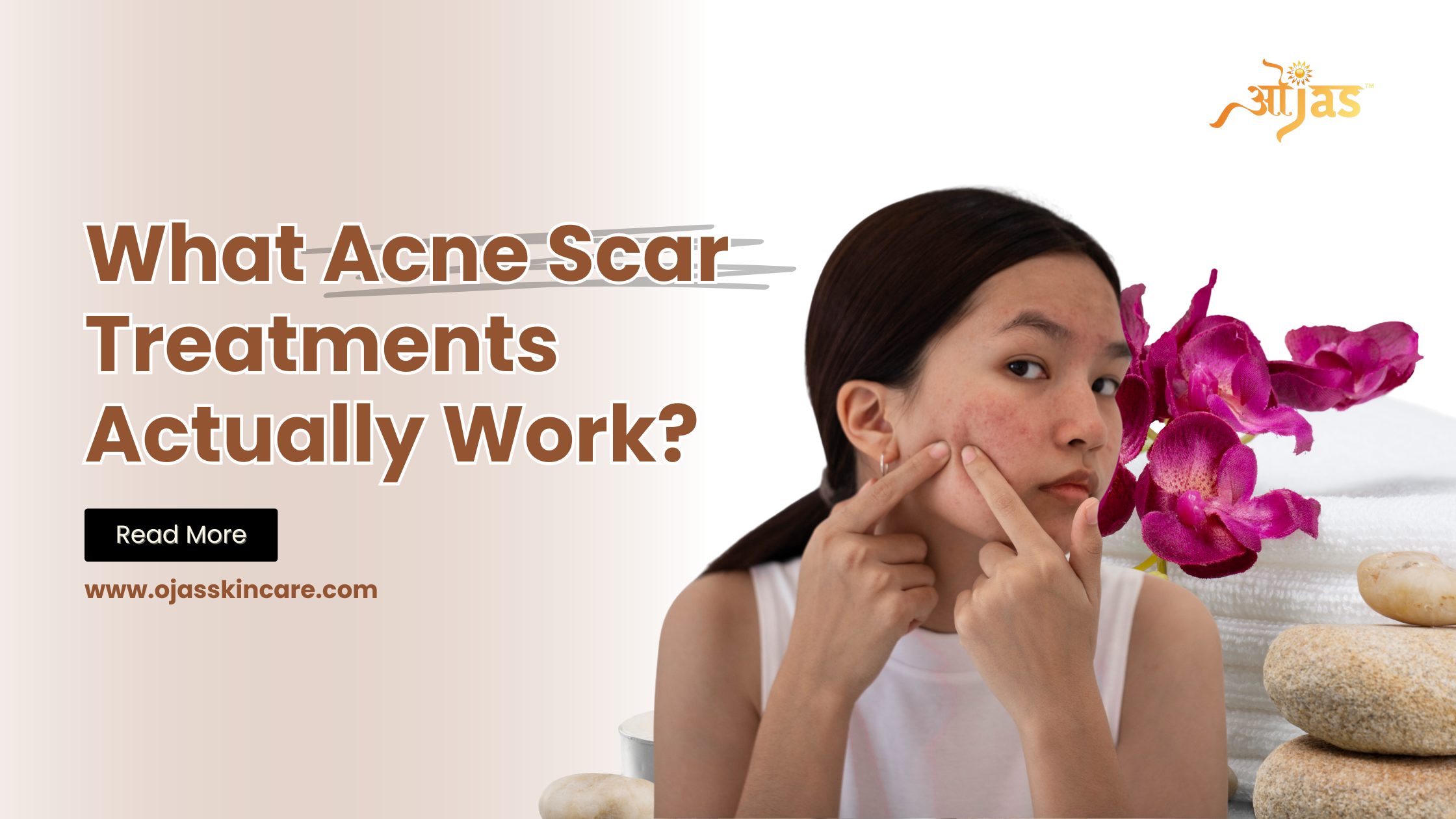What Acne Scar Treatments Actually Work?
Acne scars can turn into a challenging skin issue, however, dermatological and cosmetological solutions offer multiple potential remedies. We at Ojas Skin Care give our special attention to the anti-aging procedures, ensuring that the right techniques and equipment are used as per the patient’s case. In this blog, we will be presenting some of the best treatments to get rid of the acne scar and achieve clearer and more confident skin.
Understanding Acne Scars
Acne scars come about as a consequence of the inflammation of acne pimples. When the acne pore gets swollen, a breach in the follicle wall occurs. If the break is deep, then the infected material can spread into the surrounding tissue and therefore cause more serious scarring. The skin also begins to lay down new collagen fibers in order to repair the injury, but the healing is not as perfect as the new skin.
Types of Acne Scars
There are several types of acne scars, each requiring different treatments:
- Atrophic Scars: These are the most prevalent, and they include Ice Pick, Boxcar, and Rolling Scars. It can be characterized by sharp depressions in the skin surface.
- Hypertrophic Scars: These are hard, rough, and elevated skin lesions that are the result of high collagenization.
- Post-Inflammatory Hyperpigmentation (PIH): It is not specifically a scar because it develops when the acne lesion has already healed but presents itself as a bothering dark mark.
Effective Acne Scar Treatments
Laser Therapy
- Fractional CO2 Laser: This treatment operates at different layers of skin, encouraging collagen and skin pigmentation or altering skin texture. Its advantage is most pronounced in the case of atrophic scar treatment.
- Non-Ablative Lasers: These lasers have the ability to selectively heat the skin and the subdermal layer of the skin without affecting the outer layer, so as to trigger the creation of collagen fibers.
- Microneedling: Microneedling operates when thin needles are employed to puncture the skin, thus stimulating the body’s healing mechanisms. This helps in the creation of collagen and elastin, which are necessary in altering the skin texture and outward appearance of the scarred skin regions.
- Chemical Peels: Chemical peeling in particular involves the use of acids on the skin, which removes the outer layer of skin and causes the production of new skin cells, hence reducing the scars and appearance of marks. Peels are decided according to the type of scars. They may or may not be associated with skin peeling..
- Dermal Fillers: Dermal fillers are injected directly into the scar to level it up with the skin. It works best for rolling scars. This is common practice and uses fillers of hyaluronic acid, which gives instant results with little or no downtime.
- Subcision: Subcision is a simple surgical procedure that is employed to manage the type of scar commonly known as a rolling scar. With the aid of a needle, one can break the fibrous bands that pull the scar down. This causes the skin to go up and over, which the body’s inherent mechanism reconstructs with new collagen.
- Microdermabrasion: Microdermabrasion is one of the processes that removes the upper layer of the skin through a machine. It is less invasive than some treatments and is best for superficial scars and skin discoloration. On the other hand, it is recommended that it be done in several sessions in order to have the best impact.
- Topical Treatments: Many products that can be bought from a drug store, like Retinoids, Vitamin C Serums, and products that contain alpha hydroxy acids (AHAs) can be used to treat mild scars and hyperpigmentation. These treatments enhance the rate of cell division and promote collagen formation.
Personalized Treatment Plans
We, at Ojas Skin Care, know that every skin type is different and requires a special treatment. Our dermatologists examine the skin to identify the kind of scar and the gravity of the skin condition you are presenting. Depending on this assessment, an individualized therapy is developed, and this therapy may involve some of the treatments mentioned above in a combinational approach.
Post-Treatment Care
After the treatment, it is crucial to proceed to post-treatment care, to ensure that the gains made are not nullified:
- Sun Protection: When choosing the best type of sunscreen, do consider the type that offers a broad spectrum with an SPF of 30 and above.
- Hydration: Additionally, it is crucial that you keep your skin well moisturized so that the healing process can be facilitated.
- Gentle Skincare: Avoid using soaps and body products that trigger skin sensitivity in your body. Do not use very abrasive soaps for washing your face or when cleansing the skin in general.
- Follow-Up Appointments: Subsequent appointments with your dermatologist will involve follow-up examinations to assess your progress and modify the treatment plan.
Conclusion
Scars resulting from acne can be a bit difficult to manage, but they can be treated to reduce their severity to a large extent. At Ojas Skin Care, we have dedicated ourselves to fulfilling your skin care needs and goals. This is the reason why our dermatological practice optimizes the best of both treatment and technology to offer you the best care. Get in touch with us to discuss the best solutions for your acne scar treatment. As a team, let us work hand in hand to develop a regimen to get back the smooth skin that you want and the confidence you deserve.
